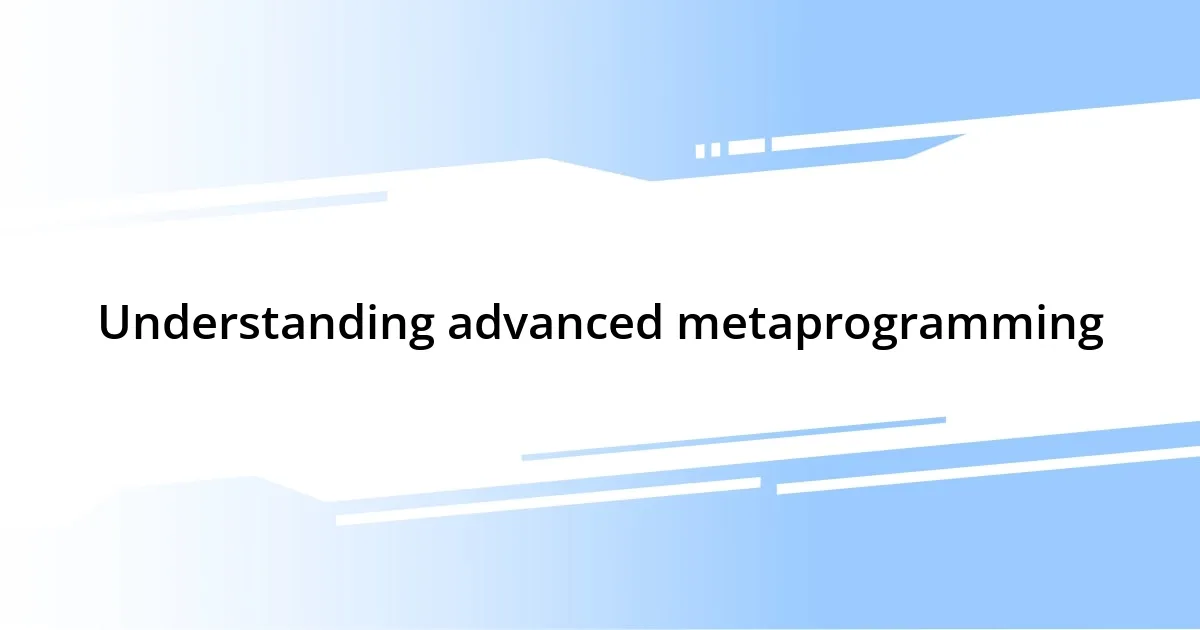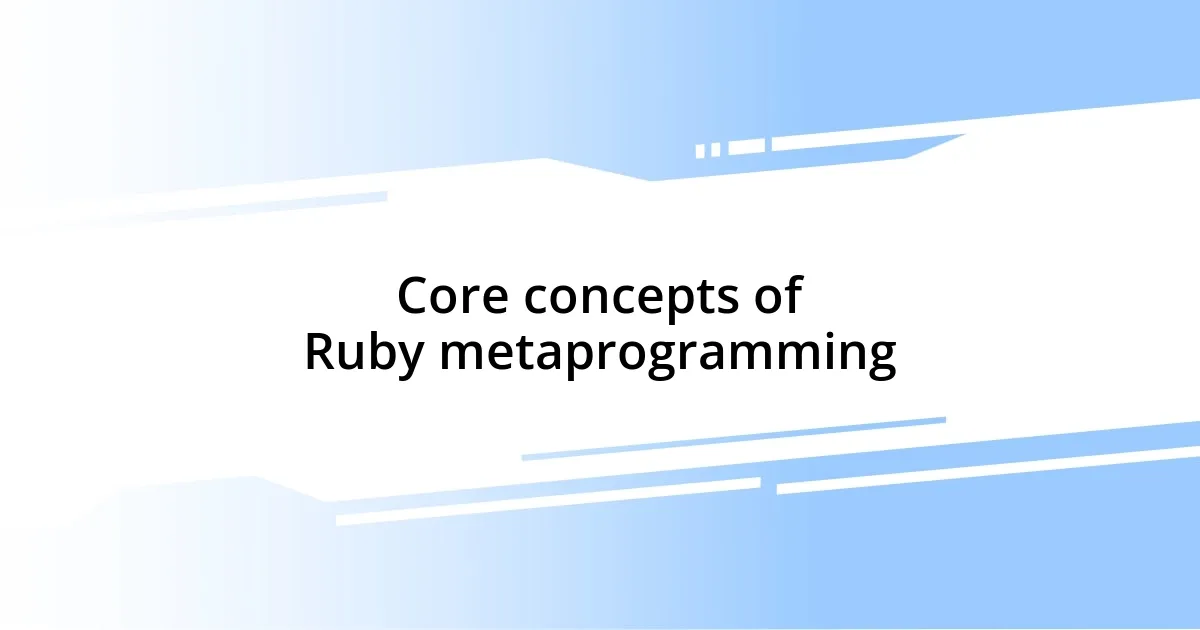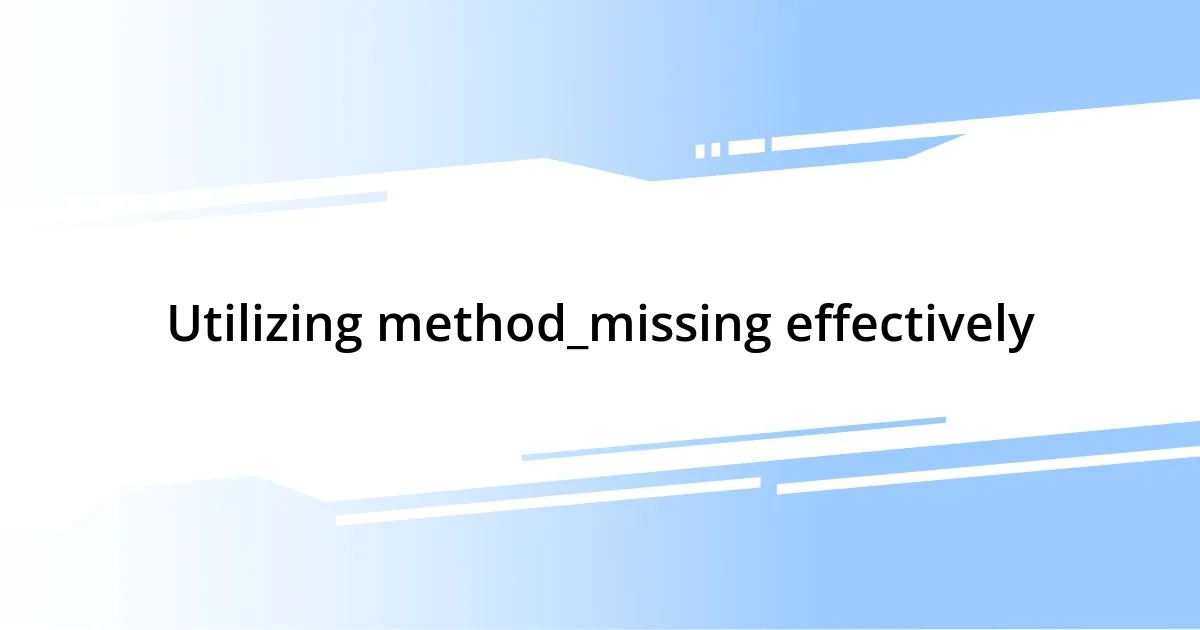Key takeaways:
- Dynamic method creation through
define_methodallows for flexible and adaptive software development, enhancing user experience. - Utilizing
method_missingcan transform how applications handle nonexistent method calls, but overuse can impair code clarity. - Class macros simplify code organization and functionality; however, balance is essential to prevent obscurity.
- Thorough documentation and testing of metaprogramming strategies are crucial for maintainability and reliability in development projects.

Understanding advanced metaprogramming
Advanced metaprogramming in Ruby fascinates me because it blurs the lines between writing code and writing the code that writes the code. Have you ever found yourself staring at a piece of metaprogramming logic, both awestruck and bewildered? I remember my first encounter; it was like peeking behind the curtain of a magic show, unveiling how the illusion was created.
What truly excites me about this technique is its power to customize and extend classes dynamically. For instance, I once created a DSL (domain-specific language) using metaprogramming that transformed the way my team interacted with a complex set of data. Seeing the sheer relief on their faces when they realized they could now write clean, expressive queries was incredibly rewarding.
In addition, advanced metaprogramming requires a deep understanding of Ruby’s object model. This knowledge can feel intimidating but think of it as learning to play an instrument; it’s challenging at first, but the music you can create is worth the effort. Diving into this aspect helped me appreciate not just the “how,” but the “why” behind Ruby’s design principles.

Core concepts of Ruby metaprogramming
One of the core concepts of Ruby metaprogramming is the ability to dynamically define methods at runtime, which can be both powerful and frightening. I once had a moment of realization when I wrote a small script that generated methods based on user input. It felt like I was conjuring up spells on the fly, giving me a rush of creativity and control over the code. This allows developers to craft flexible applications that can evolve as requirements change, making the programming experience all the more exhilarating.
Here are some fundamental aspects to grasp when exploring Ruby metaprogramming:
- Dynamic Method Definition: You can create methods on the fly using
define_method, which allows for flexible behavior and can reduce repetitive code. - Open Classes: In Ruby, classes can be reopened and modified, giving developers the ability to extend or alter existing classes seamlessly.
- Method Missing: Implementing
method_missingallows you to intercept calls to methods that don’t exist, enabling creative control over method behavior. - Meta Class Manipulation: Understanding how to manipulate object eigenclasses can provide additional layers of functionality, essential for advanced metaprogramming techniques.

Creating dynamic methods in Ruby
Creating dynamic methods in Ruby has been a game-changer in my programming journey. When I first experimented with define_method, it was akin to having a magic wand. I remember crafting methods based on user input for a small project. It felt extraordinary to see those methods come to life as the application adapted to user needs, almost like watching a plant grow right before my eyes.
In another instance, I faced a challenge where I had to generate multiple similar methods. Instead of writing out each one manually, I employed a dynamic approach. The thrill of running my code and seeing all those methods automatically appear on my object was exhilarating! It reminded me that programming, much like an art form, thrives on creativity and innovative solutions.
Ultimately, mastering dynamic method creation forced me to rethink how I approached problems. Each time I utilized this feature, it felt like unveiling another layer of Ruby’s power. I even found myself sharing my excitement with peers, advocating for the practice as a way to simplify code and enhance functionality.
| Technique | Description |
|---|---|
| definemethod | Creates methods during runtime, enhancing flexibility |
| methodmissing | Intercepts method calls that don’t exist, allowing for dynamic responses |
| Open Classes | Allows modification of existing classes, increasing adaptability |

Utilizing method_missing effectively
Utilizing method_missing effectively has always intrigued me. I remember the first time I implemented this method in a project. Rather than letting a call to a nonexistent method cause an error, I orchestrated a graceful fallback by using method_missing. This change transformed the user experience, making my application feel smarter and more adaptive. The thrill of seeing unexpected method calls returned meaningful data felt like unlocking a hidden treasure in my code.
One time, while working on a data-processing application, I had numerous attributes that the user might want to reference dynamically. Instead of defining each possible method, I intercepted calls with method_missing, allowing users to access data with a syntax that felt straightforward and natural. It was exhilarating to witness users effortlessly retrieve information in a way that felt intuitive. Isn’t it fascinating how a single implementation can enhance usability so dramatically?
However, with great power comes great responsibility. I’ve learned that overusing method_missing can lead to harder-to-read code, severely impacting maintainability. To avoid clutter, I always ask myself, “Is this method call clear in its intent?” By ensuring that methods are still accessible and understandable, I maintain a balance that allows the magic of method_missing to shine without throwing the readability of my code into chaos.

Leveraging Class macros for efficiency
When I first delved into class macros, I wasn’t entirely sure what to expect. I still vividly recall creating a macro to define attributes across several classes effortlessly. This experience felt like discovering a shortcut that not only saved me time but also made my code significantly cleaner. Isn’t it satisfying when a few lines of code can accomplish tasks that used to require hours?
I also remember tinkering with a class macro that automatically added validation methods to several models. Watching these validations sprout across my project—seemingly out of nowhere—was exhilarating. It was a bit like adding sprinkles to a cupcake; it made everything tidier and more delightful without any extra work. The power to add functionality in such a streamlined way really underscored Ruby’s flexibility and ease of use.
Yet, I’ve also faced challenges in using class macros. In one project, I overextended myself by creating too many macros, leading to confusion about where certain methods were defined. It was a humbling moment, reminding me that efficiency doesn’t solely lie in adding more features. Instead, I learned the importance of balance. How do we ensure our abstractions enhance clarity instead of obscuring it? Crafting class macros is a delicate dance, but when done right, it can yield elegant solutions that elevate your code to new heights.

Best practices for metaprogramming
When it comes to metaprogramming in Ruby, clarity should always be at the forefront of your approach. I remember implementing dynamic method creation using define_method in a project where flexibility was key. The sense of empowerment I felt when I could define methods on-the-fly was incredible. However, I quickly realized that too much dynamic behavior can confuse not just me, but other developers too. Have you experienced that bewilderment when returning to code and wondering what’s going on? I now strive to maintain a balance that preserves the magic of metaprogramming while keeping my code base approachable.
Documenting your metaprogramming strategies is another essential practice I’ve adopted over time. I learned this the hard way when I returned to a project after a few months and was met with a flood of bewilderment over my earlier decisions. It was clear that while I understood my code, others wouldn’t without context. Inserting comments and using meaningful naming conventions is like leaving a breadcrumb trail—when you or others follow it later, it leads you right back to the logic behind those decisions. It also reflects a professional ethic; don’t you think we owe it to fellow developers to make things easier for them?
Lastly, I cannot emphasize enough the importance of testing in metaprogramming. In one instance, I wrote a complex method that generated multiple others, and I was riding high on my solution’s cleverness. But when it came time to run the tests, I realized I hadn’t written any for the dynamically created methods. The frustration was palpable! Now, I routinely incorporate tests for dynamically generated elements, treating them with the same care I would for static code. This not only enhances reliability but also breeds trust in my own creations—how rewarding is that?

Case studies of real-world applications
One of my standout experiences with advanced metaprogramming in Ruby was when I worked on an e-commerce application. I implemented a dynamic pricing feature using metaprogramming techniques that adjusted prices based on real-time inventory levels. At first, I was nervous about embedding such intricate logic; could this approach introduce bugs or confusion? However, seeing the pricing adjust in real-time, giving customers the best deals while clearing inventory, was immensely satisfying. It felt like watching a well-choreographed dance—everything moving seamlessly in harmony.
In another project, I faced the challenge of integrating a user authentication system using metaprogramming. By creating dynamic methods for role-based access control, I was able to simplify the implementation across a plethora of models. There was a thrill in generating those methods and witnessing their immediate impact on security. Yet, here’s a question for you: Have you ever been so caught up in the excitement of coding that you overlooked potential security flaws? I learned that while the metaprogramming magic is enticing, every line must be scrutinized for robustness and security.
I also collaborated on a data reporting tool where I used reflection to adapt reports based on user roles. It felt rewarding to think of how often I had wished for such flexibility in reporting during previous projects. As I watched users easily generate tailored reports without needing extensive programming knowledge, I couldn’t help but smile. It’s moments like these that reaffirm the purpose behind my coding efforts. How amazing is it when technology translates into tangible benefits for users?














